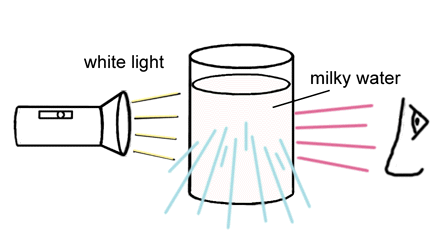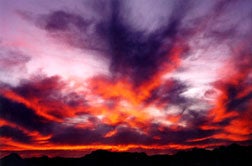Submodule 4: Blue Skies & Red Sunsets
Steve Beeson, Arizona State University

How many of us have been asked this question by our children, or, better yet, have wondered it ourselves? How many of us had an answer better than "Because the sun paints it blue as it goes across the sky"? The reason this is such a tough question to answer is because the answer is not as easy as we would like. With an easy experiment,
however, we can begin to understand exactly why our daytime sky is such a wonderful blue and why our days begin and end in red.
Put a clear glass container on a table and fill it with water. Put a few drops of milk in the water and mix it in. If using skim milk, use more drops than usual. Make sure the water is milky enough so that it's hard to see through the water. Now shine a flashlight or other directed beam of white light into one side of the container. Look at the water at a 90� angle from the light beam -- does the water seem a slightly different color? To make a comparison, shine the flashlight away from the container for a moment and shine it back in, all the while looking at the milky water. Do you see a change in the color of the water?
Now try looking through the container directly at the incoming
beam. Is there a difference in color compared to when looking from the side? If you are having trouble seeing any change in colors, try putting
more drops of milk in the water.

What we are seeing is the effects of light scattering, a process
by which some wavelengths (colors) of light are preferentially scattered out of the straight-line
path, leaving only some colors as the last vestige of the white light.
What is doing this scattering? Why doesn't it happen in clear water?
The addition of the relatively small milk particles introduces scatterers into the path of the light. Since these scatterers are about the same size as the wavelengths of the incoming light, the milk is very effective at scattering the light. Have you ever noticed how skim milk "looks" blue, while 2% or whole milk or cream looks white? The skim milk has lost all of its fat, so the milk particles are relatively small: just about the right size to scatter the white light by wavelength. With heavier milks, the size of the milk particles is much bigger so the colors are not preferentially scattered out, but the white light is nonetheless scattered in all directions. In clear water, the scatterers (the water molecules) are too few and far between to be very effective as scatterers; however, if you have a long enough path-length of water through which the light must pass, you should see the light come out blue, as in an ocean or lake.
Why are blues scattered out more than reds? Let's imagine the milk particles to be like a special kind of chain-link fence at which we will throw rocks (the photons). This fence is special because it lets the larger rocks sail through easily and scatters off the smaller rocks. So if we pick up a handful of rocks of different sizes and throw them at the fence, most of the large rocks will go through the fence, while the small pebbles will bounce off of it. In this example, we can think of the small pebbles as photons with short wavelengths (or high energy) -- blue light. The large rocks are photons with long wavelengths (or low energy) -- red light. The milk, like the fence, scatters off the short-wavelength blue light and lets the long-wavelength red light pass through. If you look all around the glass container, except right at the beam, you should see the milky water emitting a bluish glow. What's left of the scattered beam is mostly yellow and red (even the green gets scattered out pretty early, since its wavelength is shorter than red). This is why you see the light beam to be reddish or yellow when you look at it 180� from the incoming path.
So what does this have to do with the blue sky? The sky is a lot like our
milky water: the molecules of oxygen, nitrogen, and carbon compounds in the atmosphere act as the scatterers, allowing the red and yellow light to
pass easily through the atmosphere (with the fact that our sun emits predominantly yellow light, this is why our sun looks yellow) while scattering away the blue light. Anywhere we look in the sky, away
from the sun, we see the scattered blue light, since the air molecules
are so efficient at scattering the blue in all directions.

What about the sunsets and sunrises? When the sun is low on the horizon, the sunlight must pass through much more atmosphere than during the midday hours. Since the amount of scattering depends on how many scatterers there are, then more of the blue light is scattered out (and even most of the green and yellow) and the sunlight has been reduced to almost only reds. In populated areas, the inclusion of dust and pollution in the atmosphere adds to the number of scatterers, and even reddens the light by reducing its energy, so even more spectacular sunsets and sunrises can be seen over large cities.

Sunset from Joshua Tree National Park, 100 miles east of Los Angeles
 Modules
Modules
 Light & Optics
Light & Optics
 Submodule 4
Submodule 4
 Readings
Readings
 PiN Homepage
PiN Homepage
 ACEPT
ACEPT
 Glossary
Glossary
 Help
Help